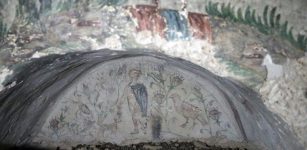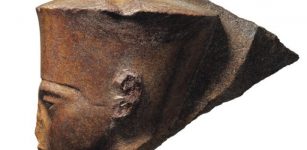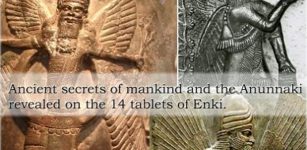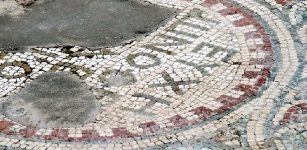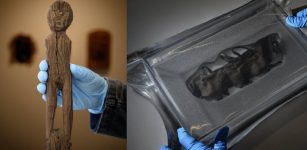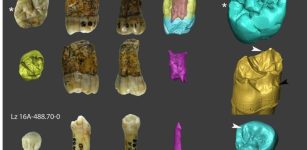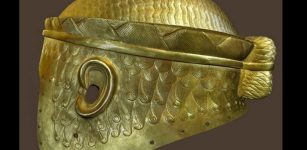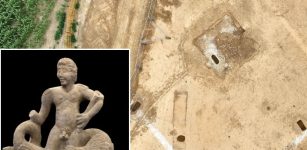Painted Tikal Altar Unlocks The Ancient Secrets Of A Mysterious Maya Period
Jan Bartek - AncientPages.com - Located just steps from the center of Tikal, a 2,400-year-old Maya city in present-day Guatemala, an international team of researchers, including scholars from Brown University, has discovered a buried altar. This find could provide insights into a mysterious period of upheaval in ancient history.
Structure 6D-XV-Sub3 altar with murals rendered from the north-west. Drawing by H. Hurst. Credit: Antiquity (2025). DOI: 10.15184/aqy.2025.3
The altar dates back to the late 300s A.D. and features four painted panels in red, black, and yellow. These panels depict a figure wearing a feathered headdress and surrounded by shields or regalia. The figure's face is characterized by almond-shaped eyes, a nose bar, and double earspools—features that closely resemble depictions of the "Storm God" deity found in central Mexico.
In their recent study, researchers propose that this painted altar was not crafted by a Maya artist but rather by an exceptionally skilled artisan trained at Teotihuacan, a powerful ancient civilization located 630 miles west of modern-day Mexico City.
"It's increasingly clear that this was an extraordinary period of turbulence at Tikal," said Stephen Houston, a professor of social science, anthropology, and history of art and architecture at Brown, University who co-authored the paper. "What the altar confirms is that wealthy leaders from Teotihuacan came to Tikal and created replicas of ritual facilities that would have existed in their home city. It shows Teotihuacan left a heavy imprint there."
Before uncovering the altar, Houston and his team knew that the Maya had engaged with Teotihuacan for centuries before their relationship intensified. Tikal, established around 850 B.C., remained a minor city with limited influence until it expanded into a significant dynasty around 100 A.D.
Archaeological findings indicate that Tikal began regular interactions with the more dominant Teotihuacan approximately two centuries later. Initially perceived as a simple trading partnership, this relationship soon evolved into something more complex and contentious, according to Houston.
"It's almost as if Tikal poked the beast and got too much attention from Teotihuacan," Houston said. "That's when foreigners started moving into the area."
Over several decades, scholars have gathered substantial evidence indicating a strained relationship between Teotihuacan and the Maya city of Tikal. This research began in the 1960s when archaeologists discovered a cut and mutilated stone with well-preserved text broadly describing the conflict. The text revealed that around A.D. 378, Teotihuacan effectively overthrew a kingdom by removing its king and installing a puppet ruler who served their interests.
In recent years, advancements in light detection and ranging (LiDAR) technology enabled Brown University scholars and colleagues to uncover a scaled-down replica of the Teotihuacan citadel near Tikal's center, previously considered natural hills. This finding suggests that before its overthrow, Teotihuacan likely maintained an element of occupation or surveillance within Tikal.
Andrew Scherer, co-author and professor at Brown University, noted that an altar built around the time of this coup provides further evidence of Teotihuacan's influence. The altar's exterior is meticulously painted; inside it contained remains reflecting practices common in Teotihuacan but rare in Tikal—such as a child buried seated—and an adult interred with a green obsidian dart point unique to Teotihuacan.
Structure 6D-XV-Sub3 altar with murals photographed from the south-west. Photograph by E. Román. Credit: Antiquity (2025). DOI: 10.15184/aqy.2025.3
The subsequent burial of this altar area supports the theory that Teotihuacan's presence significantly impacted Tikal, leaving lasting changes in its landscape and history.
"The Maya regularly buried buildings and rebuilt on top of them," Scherer said. "But here, they buried the altar and surrounding buildings and just left them, even though this would have been prime real estate centuries later. They treated it almost like a memorial or a radioactive zone. It probably speaks to the complicated feelings they had about Teotihuacan."
According to Houston, the term "complicated" aptly describes Tikal's collective memory of the Teotihuacan coup. While this event may have profoundly impacted Tikal, it ultimately strengthened the kingdom. Over subsequent centuries, Tikal ascended to unprecedented heights, establishing itself as a dominant dynasty before its decline around 900 A.D., alongside the broader Maya civilization.
"There's a kind of nostalgia about that time when Teotihuacan was at the height of its power and taking an increasing interest in the Maya," Houston said. "It's something exalted for them; they looked back on it almost wistfully. Even in decline, they were still thinking about local politics in the context of that contact with central Mexico."
See also: More Archaeology News
As Houston and Scherer delve deeper into the complex history between Teotihuacan and Tikal, they are struck by its familiarity: a powerful empire identifies a prosperous region and seeks to exploit its resources. Houston parallels well-known historical events like those involving the Aztec civilization following Spanish arrival.
Their research suggests that such narratives are timeless; central Mexican powers ventured into the Maya world attracted by its wealth—exotic feathers from tropical birds, jade, and chocolate—perceiving it as an abundant land akin to "milk and honey."
The study was published in the journal Antiquity
Written by Jan Bartek - AncientPages.com Staff Writer



